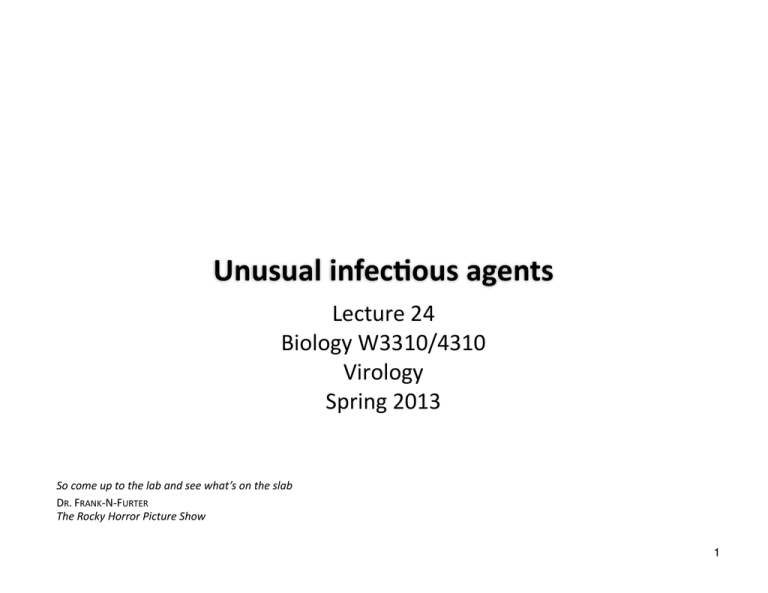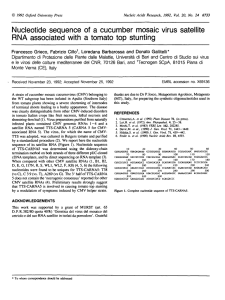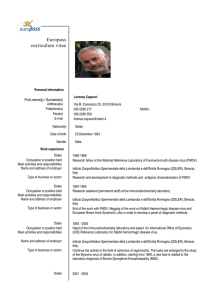
Unusual infec,ous agents
Lecture 24
Biology W3310/4310
Virology
Spring 2013
So come up to the lab and see what’s on the slab
DR. FRANK-­‐N-­‐FURTER
The Rocky Horror Picture Show
1
A fundamental ques,on
What is the minimum genome size needed to sustain an infecKous agent?
Could an infec=ous agent exist without ANY genome?
2
Viroids, satellites, and prions provide answers
•
These agents do not fit into the standard taxonomy schemes for viruses
•
•
•
Viroids are major plant pathogens
Some satellites are associated with human disease
Prions cause devastaKng and fatal demenKas
3
Viroids: pure RNA, no protein
•
Viroids lack a protecKve coat, yet migrate from host to host (no receptors required)
•
Subviral RNA database lists 1742 viroid sequences
-­‐ hDp://subviral.med.uoDawa.ca/cgi-­‐bin/home.cgi
4
Viroids
•
•
•
Unencapsidated infecKous RNA, code for no proteins
•
Classified in families Pospiviroidae (replicate in nucleus) and Avsunviroidae (replicate in chloroplasts)
RNA is small, circular and single stranded
Replicate autonomously when mechanically introduced into host plants
5
•
Potato spindle tuber viroid (PSTVd) discovered 1967
-­‐ Prototype for smallest known nucleic acid-­‐based agents of infec=ous disease
-­‐ 359 nucleo=des
•
Some are benign, others cause economically important diseases of crop plants
6
Some of my favorite viroids
•
Cadang-­‐Cadang coconut viroid
-­‐ CCCVd causes lethal disease of coconut palms
-­‐ Pina colada drinkers are sad
•
Hop latent viroid
-­‐ HLVd -­‐ no symptoms in the hop plant
-­‐ Beer lovers are relieved
•
Apple scar skin viroid
-­‐ ASSVd -­‐ mild symptoms; apples look bad, taste good
-­‐ Picky consumers don’t buy these apples
7
Viroids do not encode proteins or mRNA
•
•
Circular ssRNA molecules, 246 -­‐ 399 nt
•
Several well-­‐studied viroid RNA molecules are ribozymes
RNA displays extensive internal base-­‐pairing, appears as 50 nm rod in EM
-­‐ Ac=vity essen=al for replica=on
•
DisKncKon from the virus life style
-­‐ Viruses are parasites of host transla=on machinery
-­‐ Viroids are parasites of host transcrip=on machinery
8
Func,onal regions of viroid RNA
PSTVd
9
How do viroids replicate?
•
•
Concatemers of viroid RNA produced by host RNA polymerase II
Cuang is done by the viroid RNA
-­‐ A ribozyme
-­‐ Ability of RNA to catalyze a reac=on in the absence of protein discovered 1981
•
One group of viroids forms ‘hammerhead ribozyme’
-­‐ Autocataly=c, self cleaving RNA
-­‐ Used to cleave mul=meric structures produced during replica=on
-­‐ Other viroids use host nuclear enzymes
10
11
12
Origin of viroids
•
Originated in the 20th century by chance transfer from wild plants used in breeding modern crops
•
Widespread use of geneKcally idenKcal plants (monoculture)
•
•
Worldwide distribuKon of plant breeding lines
Mechanical transmission by contaminated farm machinery
13
How do viroids cause disease?
•
Small 21-­‐24 nt RNAs (siRNAs) derived from viroid RNAs in plants may guide RNA silencing of host genes and induce disease
•
Symptom development correlates with producKon of small RNAs
•
Many siRNAs map to pathogenicity-­‐modulaKng domain of viroid
14
Satellites
•
Mostly small, single-­‐stranded RNA molecules, 500-­‐2000 nt
•
Some encode 1-­‐2 structural proteins that encapsidate the genome (form disKnct parKcles); others none
•
Lack genes required for replicaKon, some lack encapsidaKon genes
•
Replicate in the presence of another virus (helper virus -­‐ provides replicaKon, capsid proteins) 15
Satellites
•
In plants, satellites cause disKnct disease symptoms not seen with the helper virus alone
•
Satellites are not defecKve viruses derived from the helper
-­‐
Genomes have no homology with helper
16
Satellites
Subviral agents that depend on another virus (the helper virus) for their mul=plica=on
17
Hepa,,s delta virus
•
•
•
A strange cross between a viroid and a satellite
Helper virus is hepaKKs B virus
Originally thought to make HBV liver disease more severe; now is controversial
18
HDV global distribu,on
•
18 million people HDV infected; 5% of 350 million carriers of HBV
•
Declining in Europe, Asia-­‐Pacific region highly prevalent
19
HDV genome
1.7 kb
ribozyme
Principles of Virology, ASM Press
20
HDV and HBV
21
HDV replica,on
Principles of Virology, ASM Press
22
Hepa,,s delta virus
•
HDV genome is 1.7 kb single stranded, circular RNA that folds upon itself to form a Kght rodlike structure (70% base paired)
•
•
HDV RNA is also a ribozyme required for replicaKon
•
Upon egress from infected cell, HDV satellite nucleocapsid acquires envelope of HBV
•
HDV satellite virion comprises surface anKgen of HBV and delta anKgen
HDV genome encodes a protein (delta anKgen) that encapsidates genome
23
Virophages
•
Derived from bacteriophage (phagein = Greek, to eat), means ‘virus eater’
•
•
•
Circular dsDNA viruses, icosahedral
Replicate only in cells infected with a giant virus
Interfere with helper virus replicaKon
24
Virophages
25
26
Virophages
•
Mavirus -­‐ virophage of giant virus of Cafeteria roenbergensis, a marine phagotropic flagellate
•
Organic Lake virophage of phycodnaviruses that infect algae
•
•
Gene exchangers?
Impact on ocean ecology?
27
Virophages are like satellites, except that they are much larger and inhibit produc,on of the helper virus
28
Prions: Infec,ous proteins, no nucleic acid
•
Prions in the news
-­‐
BSE, mad cow disease, CJD, scrapie, kuru, chronic was=ng disease of deer and elk
-­‐
1997 Nobel Prize in Medicine -­‐ Stanley Prusiner
29
Transmissible spongiform encephalopathies
•
•
•
•
Encephalopathy -­‐ disease of the brain •
By 2002, 120 humans had contracted Creutzfeld-­‐
Jacob disease, from consumpKon of meat from animals with BSE
InfecKous agents without genomes
Fatal neurodegeneraKve disorders of mammals
Thousands of humans diagnosed each year, 1% arise by infecKon
30
•
TSE diseases of animals
-­‐ Bovine spongiform encephalopathy (BSE) (“mad cow -­‐
-­‐
-­‐
•
-­‐
-­‐
disease”)
Chronic was=ng disease (CWD) (deer, elk, moose)
Exo=c ungulate encephalopathy (EUE) (nyala and greater kudu)
Feline spongiform encephalopathy (FSE) (domes=c and great cats)
Scrapie in sheep and goats
Transmissible mink encephalopathy (TME)
TSE diseases of humans
-­‐
-­‐
-­‐
-­‐
-­‐
Creutzfeldt-­‐Jakob disease (CJD)
Fatal familial insomnia (FFI)
Gerstmann-­‐Sträussler syndrome (GSS)
Kuru
Variant CJD disease (vCJD)
31
Spongiform
•
•
Infected brain has sponge-­‐like holes throughout
•
Symptoms depend on which part of the brain is damaged
•
Each disease has a characterisKc symptomatology and pathology
All characterized by severe psychomotor dysfuncKon in infected animal
32
33
Scrapie
•
•
•
First TSE recognized
•
Recognized as disease of European sheep for over 250 years
•
Endemic in some countries: UK, 1% of sheep/yr
Infected sheep rub on fences
Motor disturbances, uncontrollable trembling (tremblant du mouton), paralysis, weight loss, death 4-­‐6 weeks
34
Scrapie
35
Scrapie
•
Sheep farmers found that animals could transmit scrapie to healthy herds: infecKous agent
•
1939: infecKvity from sheep brains shown to pass through filters which pass only viruses
•
Agent is highly resistant to UV, ionizing radiaKon, formaldehyde
•
Believed not to contain nucleic acid; clearly not typical infecKous agents
36
37
TSEs
•
All animal and human TSEs exhibit the same histochemical abnormaliKes
-­‐ Defect in plasma membrane forma=on
-­‐ Vacuola=on of neurons, astrocytes, oligodendrocytes
-­‐ Loss of neurons in gray maDer of brain
-­‐ Spongiform appearance
-­‐ Accumula=on of glial fibrillary acidic protein in clumps
-­‐ Amyloidosis in brain; fibrils of amyloid precursor protein
38
TSE pathogenesis
•
Agent detected by injecKon of organ homogenates into suscepKble species
•
Cerebellar ataxia, demenKa, death amer many months or years
•
Agent first accumulates in lymphoreKcular and secretory organs, then spreads to the CNS
•
In CNS, pathology includes astrocytosis, vacuolizaKon (spongiform), loss of neurons
•
No inflammatory, anKbody, or cellular response
39
TSEs
•
•
•
Undetected before symptoms develop
Untreatable; no way to alleviate symptoms
Invariably fatal
40
Prions
proteinaceous infec,ous par,cles
•
1967 Griffith suggested that TSE agents were protein only
•
1981 Prusiner idenKfied infecKous protein complexes in scrapie brain, purified protein, transmioed to animals
•
He called the agent a prion, (proteinaceous and infecKous parKcle)
•
Encoded by prnp gene, essenKal for pathogenesis of TSEs
41
Current view of prions
•
Pathogenic prion is a conformaKonal isoform of a normal host protein, PrPc
•
PrPc is found predominantly on the outer surface of neurons, GPI anchor
•
The abnormal conformer, when introduced into the organism, causes conversion of normal PrPc into the pathogenic conformaKon (PrPsc for scrapie)
42
PrPc to PrPsc
Principles of Virology, ASM Press
43
Prion hypothesis
•
Mice lacking both copies of prnp are resistant to infecKon
•
PrPsc can be introduced ('infecKon') or produced by rare mutaKons in prnp
•
PrPsc accumulates in CNS, leading to symptoms
44
Three types of spongiform encephalopathies
•
InfecKous or transmissible spongiform encephalopathy
•
•
•
Familial spongiform encephalopathy
•
TSE agents appear spontaneously, then transmioed
Sporadic spongiform encephalopathy
All three diseases can be transmioed experimentally to animals by inoculaKon or ingesKon of infected Kssue
45
Human TSE
•
InfecKous or transmissible
-­‐
-­‐
Kuru
-­‐
-­‐
BSE: feeding infected animals to caole
Iatrogenic spread by transplantaKon of infected corneas, hormones, transfusion from paKents with CJD
Variant CJD (new human disease): eaKng BSE beef
46
Human TSE
•
Kuru: fatal encephalopathy found in Fore people of New Guinea
•
•
30 year incubaKon period
•
When cannabalism ceased, so did kuru
Found by Carleton Gajdusek to spread among women and children through ritual cannabalism of brains of deceased relaKves
47
Forced cannibalism spreads BSE
•
Epidemic spread of bovine spongiform encephalopathy (BSE, mad cow disease) among BriKsh caole was a form of cannibalism
48
Forced cannibalism spreads BSE
• Resulted from the pracKce of feeding processed animal byproducts (including sheep with scrapie) to caole as protein supplements
• In the 1970s method of preparing MBM changed, allowed scrapie proteins to survive and pass into cows
• Mad cow disease stopped when animal byproduct feeding stopped
• Strong evidence that consumpKon of BSE-­‐infected beef transmits bovine TSE to humans
• variant CJD (new disease): eaKng BSE beef
49
1-­‐2 million caQle were infected with prions
IncubaKon Kme 5 yr, slaughtered 2-­‐3 yr
50
Prions in the food supply
•
New cases of BSE in caole sKll being found, one last year in CA during this course, 1390 in 2003
•
•
Most are likely to be sporadic
•
•
DiagnosKc tests have been developed
Efforts are aimed at protecKng the food supply, but in US and Canada <2% of slaughtered caole are tested
Screening for drugs that block accumulaKon of prions in cultured cells
51
Sporadic CJD
•
Affects < 1 million humans worldwide, 50 -­‐70 years of age; 65% of TSE
•
Disease appears with no warning or epidemiological indicaKons
•
•
•
PaKents have normal PrP genes
Can be transmioed to others leading to CJD
Kuru may have been established in New Guinea by eaKng brain of person with sporadic CJD
52
Familial spongiform encephalopathy
•
•
An inherited disease, geneKc basis
•
Organs, corneas, blood products from people afflicted with sporadic CJD can be infecKous, transmit CJD to others
Associated with autosomal dominant mutaKon in the prnp gene
53
Spongiform encephalopathies and prion protein
Principles of Virology, ASM Press
54
Prion species barrier
•
InoculaKon of diseased brain material into same species reproduces disease
•
•
InoculaKon into different species is inefficient
•
Transgenic mice synthesizing bovine PrPc can be efficiently infected with BSE prions
•
Barrier to interspecies transmission is in the sequence of PrP protein
Sequences of PrPsc in inoculum and PrPc in host should be isologous
55
Prion species barrier
•
•
•
BSE PrPsc has broad host range, infects many meat eaKng mammals including humans
Clearly some prions overcome the influence of primary sequence on host range
This is why BSE is a concern
56
Chronic was,ng disease -­‐ TSE of deer, elk, moose
Hunters beware!
Do not shoot, handle or consume an elk or deer that
is acting abnormally or appears to be sick. When
field-dressing game, wear rubber gloves and
minimize the use of a bone saw to cut through the
brain or spinal cord (backbone). Bone out the meat.
Minimize contact with and do not consume brain or
spinal cord tissues, eyes, spleen, or lymph nodes.
Always wash hands thoroughly after dressing and
processing game meat.
hop://www.cwd-­‐info.org/
57
Chronic was,ng disease
•
In standing herds up to 90% of mule deer and 60% of elk are posiKve
•
•
Incidence in wild cervids as high as 15%
•
In the lab, brain homogenates from deer transmit disease to cows
•
Could CWD prions transmit to caole grazing in contaminated pastures?
Transmission by contaminaKon of grass with saliva and feces?
58
59
Not all prions cause disease
•
Prions have also been idenKfied in Saccharomyces cerevisiae and Podospora anserina
•
•
They do not cause disease
•
May facilitate adaptaKon of yeast to stressful environments
Prion-­‐mediated conformaKonal changes funcKon as epigeneKc switches that modify protein funcKons and cell phenotypes
60
61


